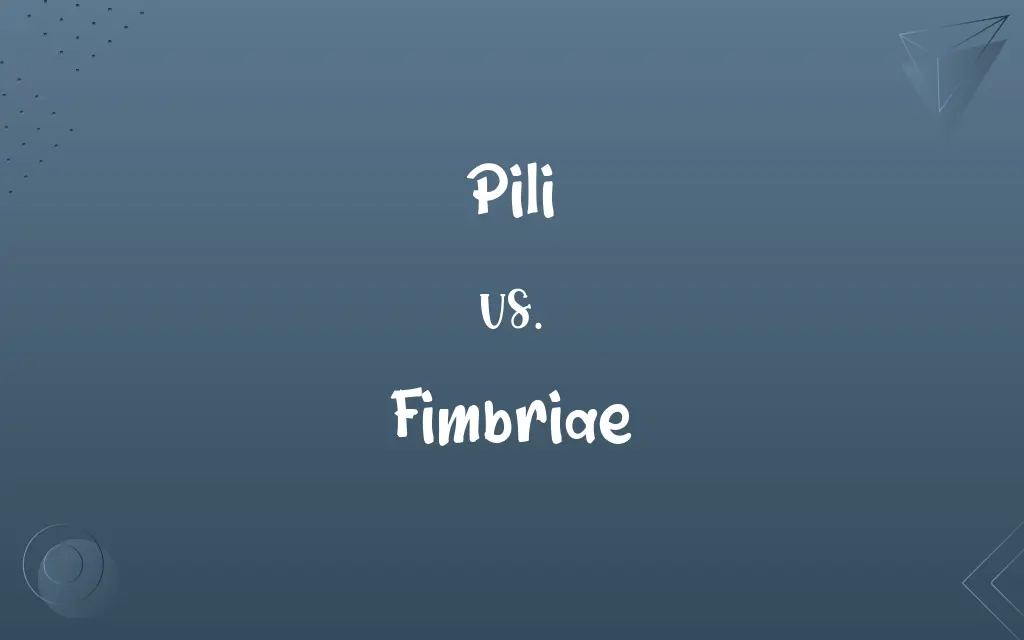Pili vs. Fimbriae: Know the Difference

By Shumaila Saeed || Updated on December 25, 2023
Pili are hair-like structures on bacterial cells, aiding in adhesion and genetic exchange; Fimbriae are also hair-like but primarily assist in adhesion, not genetic exchange.

Key Differences
Pili are appendages found on bacteria, playing a role in the process of conjugation, a form of genetic transfer. Fimbriae, while similar in appearance, mainly function in helping bacteria attach to surfaces and cells, rather than in genetic exchange.
Shumaila Saeed
Nov 15, 2023
In terms of structure, pili are typically longer and fewer in number on bacterial cells. Fimbriae are usually shorter and more numerous, covering the bacterial surface more densely.
Shumaila Saeed
Nov 15, 2023
Pili are known for their involvement in bacterial motility, specifically in twitching and gliding motions. On the other hand, fimbriae do not play a significant role in motility but are crucial for establishing bacterial colonies by aiding in adhesion.
Shumaila Saeed
Nov 15, 2023
The synthesis of pili involves complex genetic and cellular mechanisms, highlighting their role in bacterial communication and transfer of genetic material. Fimbriae synthesis is less complex, reflecting their primary function of adherence.
Shumaila Saeed
Nov 15, 2023
Pili are prominent in certain types of bacteria, such as Neisseria gonorrhoeae, which uses them for pathogenic purposes. In contrast, fimbriae are common in bacteria like Escherichia coli, aiding in gut colonization.
Shumaila Saeed
Nov 15, 2023
ADVERTISEMENT
Comparison Chart
ADVERTISEMENT
Pili and Fimbriae Definitions
Pili
Structures aiding in bacterial adhesion and motility.
The scientist observed the bacteria's pili facilitating its movement.
Shumaila Saeed
Nov 15, 2023
Fimbriae
Appendages aiding bacterial colonization.
Effective colonization was facilitated by the bacteria's fimbriae.
Shumaila Saeed
Nov 15, 2023
Pili
Protein filaments on bacteria for surface attachment.
The bacterium's pili helped it adhere to the host's tissue.
Shumaila Saeed
Nov 15, 2023
Fimbriae
Short, hair-like structures on bacteria for adhesion.
The bacteria used its fimbriae to attach to the intestinal wall.
Shumaila Saeed
Nov 15, 2023
Pili
A hair-like appendage on bacterial cells for genetic exchange.
The bacterium used its pili to transfer DNA to a neighboring cell.
Shumaila Saeed
Nov 15, 2023
ADVERTISEMENT
Fimbriae
Protein filaments on bacteria, enhancing surface attachment.
The bacterium's fimbriae increased its adherence to surfaces.
Shumaila Saeed
Nov 15, 2023
Pili
Appendages involved in bacterial conjugation.
Conjugation was possible due to the presence of pili on the bacterial surface.
Shumaila Saeed
Nov 15, 2023
Fimbriae
Cellular appendages for bacterial aggregation.
The fimbriae were essential for the bacteria to form clusters.
Shumaila Saeed
Nov 15, 2023
Pili
Cellular structures in bacteria for genetic communication.
The pili played a crucial role in the bacterial colony's genetic exchange.
Shumaila Saeed
Nov 15, 2023
Fimbriae
Structures on bacteria for host interaction.
Through its fimbriae, the bacteria interacted with the host cells.
Shumaila Saeed
Nov 15, 2023
Fimbriae
A fringelike part or structure, as at the opening of the fallopian tubes.
Shumaila Saeed
Oct 19, 2023
Pili
A tropical tree, Canarium ovatum, native to maritime Southeast Asia, New Guinea and northern Australia, and cultivated in the Philippines for its nuts.
Shumaila Saeed
Oct 19, 2023
Repeatedly Asked Queries
What is the primary function of fimbriae?
Fimbriae primarily function in bacterial adhesion.
Shumaila Saeed
Nov 15, 2023
Can pili be found on all bacteria?
No, pili are specific to certain bacterial species.
Shumaila Saeed
Nov 15, 2023
What are pili?
Hair-like structures on bacteria for genetic exchange and adhesion.
Shumaila Saeed
Nov 15, 2023
How many pili does a bacterium have?
The number varies, but generally, bacteria have fewer pili.
Shumaila Saeed
Nov 15, 2023
Do fimbriae play a role in genetic exchange?
Fimbriae are not typically involved in genetic exchange.
Shumaila Saeed
Nov 15, 2023
Are pili involved in bacterial motility?
Yes, pili aid in certain types of bacterial motility.
Shumaila Saeed
Nov 15, 2023
What role do fimbriae play in disease?
Fimbriae aid in bacterial adhesion, a key step in many infections.
Shumaila Saeed
Nov 15, 2023
Can pili be a target for antibiotics?
Yes, disrupting pili formation can hinder bacterial processes.
Shumaila Saeed
Nov 15, 2023
Are fimbriae visible under a microscope?
Fimbriae are small but can be seen with powerful microscopes.
Shumaila Saeed
Nov 15, 2023
How do pili differ from fimbriae?
Pili are longer, involved in genetic transfer; fimbriae are shorter, aiding in adhesion.
Shumaila Saeed
Nov 15, 2023
Do all bacteria with pili exhibit twitching motility?
Not all; this is specific to certain bacteria with specialized pili.
Shumaila Saeed
Nov 15, 2023
How do fimbriae impact bacterial survival?
They enhance survival by aiding in adherence and nutrient acquisition.
Shumaila Saeed
Nov 15, 2023
Do fimbriae contribute to antibiotic resistance?
Indirectly, by aiding in adherence and biofilm formation.
Shumaila Saeed
Nov 15, 2023
Can the presence of pili indicate a pathogenic bacterium?
In some cases, yes, particularly in bacteria that use pili for infection.
Shumaila Saeed
Nov 15, 2023
Can pili be used for bacterial DNA transfer?
Yes, pili facilitate the transfer of DNA between bacteria.
Shumaila Saeed
Nov 15, 2023
Do fimbriae vary among different bacterial species?
Yes, there can be variations in structure and function among species.
Shumaila Saeed
Nov 15, 2023
How do fimbriae aid in bacterial colonization?
Fimbriae help bacteria attach to surfaces, forming colonies.
Shumaila Saeed
Nov 15, 2023
What is the structural composition of pili?
Pili are composed of protein subunits.
Shumaila Saeed
Nov 15, 2023
Are fimbriae a universal feature of bacteria?
No, not all bacteria possess fimbriae.
Shumaila Saeed
Nov 15, 2023
Is the synthesis of pili a complex process?
Yes, it involves multiple genetic and cellular mechanisms.
Shumaila Saeed
Nov 15, 2023
Share this page
Link for your blog / website
HTML
Link to share via messenger
About Author
Written by
Shumaila SaeedShumaila Saeed, an expert content creator with 6 years of experience, specializes in distilling complex topics into easily digestible comparisons, shining a light on the nuances that both inform and educate readers with clarity and accuracy.









































































